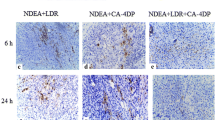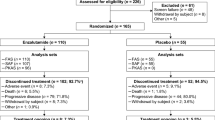Abstract
Purpose
Recent studies have demonstrated that frequent, low-dose metronomic (MET) dosing of cytotoxic agents may not only be as efficient as conventional maximum tolerated dose (MTD) chemotherapy but also less toxic. In this study, we investigated the therapeutic effect and safety of MET chemotherapy using cyclophosphamide (CTX) in rats with chemically induced hepatocellular carcinoma (HCC).
Methods
Rats received weekly intraperitoneal (i.p.) injections of diethylnitrosamine during 16 weeks for induction of HCC. The rats were divided into three groups: MTD group received 40 mg/kg CTX i.p. injection on days 1, 3, and 5 of a 21-day cycle; Control and MET groups received saline and 20 mg/kg CTX i.p. injection twice a week, respectively. The growth-modulating effects and overall survival were compared between the groups. Anti-angiogenic effects were evaluated by a measurement of endothelial cell and VEGFR-2 expression.
Results
At 6 weeks of therapy, MTD and MET chemotherapy resulted in a significant reduction in tumor number and size compared with Control group. MET chemotherapy showed more prolonged survival than MTD chemotherapy and Control groups (P < 0.05). MET chemotherapy resulted in a significant decrease in both the micro-vessel density and endothelial proliferation index (P < 0.01). Furthermore, MET chemotherapy led to a greater decrease in VEGFR-2 expression at the mRNA and protein levels (P < 0.01).
Conclusions
MET scheduling not only exhibits anti-tumor and anti-angiogenic effects, but also prolongs survival without major toxicities in a rat model of HCC. Our results suggest that MET chemotherapy has a high therapeutic value and should be considered for future clinical trials.






Similar content being viewed by others
Abbreviations
- HCC:
-
Hepatocellular carcinoma
- MTD:
-
Maximum tolerated dose
- MET:
-
Metronomic
- VEGF:
-
Vascular endothelial growth factor
- DEN:
-
Diethylnitrosamine
- CTX:
-
Cyclophosphamide
- PCNA:
-
Proliferating cell nuclear antigen
- vWF:
-
von-Willebrand factor
- RT-PCR:
-
Reverse transcription-polymerase chain reaction
- PAGE:
-
Polyacylamide gel electrophoresis
References
Block TM, Mehta AS, Fimmel CJ, Jordan R (2003) Molecular viral oncology of hepatocellular carcinoma. Oncogene 22:5093–5107
Song TJ, Ip EW, Fong Y (2004) Hepatocellular carcinoma: current surgical management. Gastroenterology 127:248–260
Bocci G, Francia G, Man S, Lawler J, Kerbel RS (2003) Thrombospondin 1, a mediator of the antiangiogenic effects of low-dose metronomic chemotherapy. Proc Natl Acad Sci USA 100:12917–12922
Hanahan D, Bergers G, Bergsland E (2000) Less is more, regularly: metronomic dosing of cytotoxic drugs can target tumor angiogenesis in mice. J Clin Invest 105:1045–1047
Kerbel RS, Kamen BA (2004) The anti-angiogenic basis of metronomic chemotherapy. Nat Rev Cancer 4:423–436
Browder T, Butterfield CE, Kraling BM, Shi B, Marshall B, O’Reilly MS, Folkman J (2000) Antiangiogenic scheduling of chemotherapy improves efficacy against experimental drug-resistant cancer. Cancer Res 60:1878–1886
Gasparini G (2001) Metronomic scheduling: the future of chemotherapy? Lancet Oncol 2:733–740
Stempak D, Seely D, Baruchel S (2006) Metronomic dosing of chemotherapy: applications in pediatric oncology. Cancer Invest 24:432–443
Giavazzi R, Taraboletti G (1999) Angiogenesis and angiogenesis inhibitors in cancer. Forum (Genova) 9:261–272
Risau W (1997) Mechanisms of angiogenesis. Nature 386:671–674
Veikkola T, Alitalo K (1999) VEGFs, receptors and angiogenesis. Semin Cancer Biol 9:211–220
Yancopoulos GD, Davis S, Gale NW, Rudge JS, Wiegand SJ, Holash J (2000) Vascular-specific growth factors and blood vessel formation. Nature 407:242–248
Bergers G, Benjamin LE (2003) Tumorigenesis and the angiogenic switch. Nat Rev Cancer 3:401–410
Carmeliet P (2000) Mechanisms of angiogenesis and arteriogenesis. Nat Med 6:389–395
Ferrara N, Gerber HP, Le Couter J (2003) The biology of VEGF and its receptors. Nat Med 9:669–676
Bertolini F, Paul S, Mancuso P, Monestiroli S, Gobbi A, Shaked Y, Kerbel RS (2003) Maximum tolerable dose and low-dose metronomic chemotherapy have opposite effects on the mobilization and viability of circulating endothelial progenitor cells. Cancer Res 63:4342–4346
Man S, Bocci G, Francia G, Green SK, Jothy S, Hanahan D, Bohlen P, Hicklin DJ, Bergers G, Kerbel RS (2002) Antitumor effects in mice of low-dose (metronomic) cyclophosphamide administered continuously through the drinking water. Cancer Res 62:2731–2735
Stolting S, Klink T, Bela C, Engels C, Wagner T (2004) Metronomic scheduling of trofosfamide chemotherapy in human NSCLC xenografts highly increases therapeutic efficacy compared to conventional scheduling by inhibition of angiogenesis. Int J Clin Pharmacol Ther 42:652–653
Lee TY, Kim KT, Han SY (2007) Expression of ErbB receptor proteins and TGF-alpha during diethylnitrosamine-induced hepatocarcinogenesis in the rat liver. Korean J Hepatol 13:70–80
Schiffer E, Housset C, Cacheux W, Wendum D, Desbois-Mouthon C, Rey C, Clergue F, Poupon R, Barbu V, Rosmorduc O (2005) Gefitinib, an EGFR inhibitor, prevents hepatocellular carcinoma development in the rat liver with cirrhosis. Hepatology 41:307–314
Gavrieli Y, Sherman Y, Ben-Sasson SA (1992) Identification of programmed cell death in situ via specific labeling of nuclear DNA fragmentation. J Cell Biol 119:493–501
Pang LP, Huang W, Sun Q, Guo W, Li RT, Cui JR (2008) SLXM-2, a derivative of cyclophosphamide: mechanism of growth inhibition on hepatocarcinoma 22 cells. Anticancer Drugs 19:167–174
Lindner G, Botchkarev VA, Botchkareva NV, Ling G, van der Veen C, Paus R (1997) Analysis of apoptosis during hair follicle regression (catagen). Am J Pathol 151:1601–1617
Mirkes PE, Little SA (2000) Cytochrome c release from mitochondria of early postimplantation murine embryos exposed to 4-hydroperoxycyclophosphamide, heat shock, and staurosporine. Toxicol Appl Pharmacol 162:197–206
Shaked Y, Emmenegger U, Francia G, Chen L, Lee CR, Man S, Paraghamian A, Ben-David Y, Kerbel RS (2005) Low-dose metronomic combined with intermittent bolus-dose cyclophosphamide is an effective long-term chemotherapy treatment strategy. Cancer Res 65:7045–7051
Miller KD, Sweeney CJ, Sledge GW Jr (2001) Redefining the target: chemotherapeutics as antiangiogenics. J Clin Oncol 19:1195–1206
Meyer M, Clauss M, Lepple-Wienhues A, Waltenberger J, Augustin HG, Ziche M, Lanz C, Buttner M, Rziha HJ, Dehio C (1999) A novel vascular endothelial growth factor encoded by Orf virus, VEGF-E, mediates angiogenesis via signalling through VEGFR-2 (KDR) but not VEGFR-1 (Flt-1) receptor tyrosine kinases. EMBO J 18:363–374
Rahimi N, Dayanir V, Lashkari K (2000) Receptor chimeras indicate that the vascular endothelial growth factor receptor-1 (VEGFR-1) modulates mitogenic activity of VEGFR-2 in endothelial cells. J Biol Chem 275:16986–16992
Veikkola T, Alitalo K (1999) VEGFs, receptors and angiogenesis. Semin Cancer Biol 9:211–220
Longley DB, Johnston PG (2005) Molecular mechanisms of drug resistance. J Pathol 205:275–292
Raguz S, Yague E (2008) Resistance to chemotherapy: new treatments and novel insights into an old problem. Br J Cancer 99:387–391
Jia LJ, Wei DP, Sun QM, Jin GH, Li SF, Huang Y, Hua ZC (2007) Tumor-targeting Salmonella typhimurium improves cyclophosphamide chemotherapy at maximum tolerated dose and low-dose metronomic regimens in a murine melanoma model. Int J Cancer 121:666–674
Hermans IF, Chong TW, Palmowski MJ, Harris AL, Cerundolo V (2003) Synergistic effect of metronomic dosing of cyclophosphamide combined with specific antitumor immunotherapy in a murine melanoma model. Cancer Res 63:8408–8413
Acknowledgments
This research was supported by The Korean Association for the Study of the Liver, grant no. 0620390 from the National R&D Program for Cancer Control, Ministry for Health, Welfare and Family Affairs, Republic of Korea, and the second stage of Brain Korea 21 project.
Conflict of interest statement
There are no conflicts of interest in this work.
Author information
Authors and Affiliations
Corresponding author
Additional information
S. T. Park and J. W. Jang equally contributed to this work.
Rights and permissions
About this article
Cite this article
Park, S.T., Jang, J.W., Kim, G.D. et al. Beneficial effect of metronomic chemotherapy on tumor suppression and survival in a rat model of hepatocellular carcinoma with liver cirrhosis. Cancer Chemother Pharmacol 65, 1029–1037 (2010). https://doi.org/10.1007/s00280-009-1108-4
Received:
Accepted:
Published:
Issue Date:
DOI: https://doi.org/10.1007/s00280-009-1108-4




